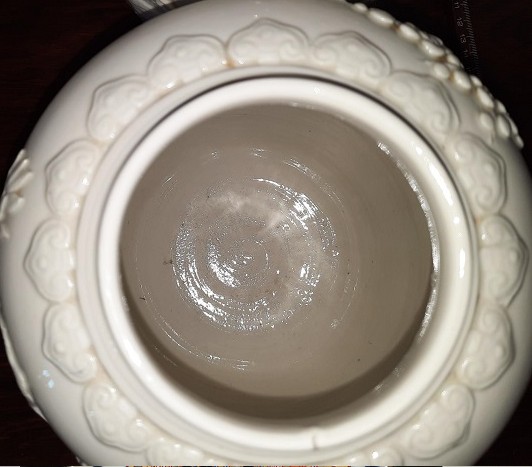
In porcelain decorations sometimes only the upper rounded part of the Ruyi scepter - the head - is depicted as a cloud shape, or linked in a row forming a border. The jar is probably from the Chaozhou kiln in Guangdong and from the first decades of the 20th century.
Photo courtesy of Nomi Meivar, 2021.
Standard Chinese uses ruyi either as a stative verb meaning "as desired; as one wishes, as one likes; according to one's wishes; following your heart's desires", or as an adjective meaning "satisfied, pleased, happy, comfortable
Chinese "as you whish" or "may your wish be granted". Ruyi scepters in the stylized form of a lotus flower with stalk, has traditionally been presented as birthday gifts. A Ruyi / lotus scepter is also the emblem of He Xiangu, one of the Eight Daoist immortals. The Yang (female principle) character of the Ruyi is often indicated by its similarity to the Lingzhi fungus and to clouds.
A traditional ruyi scepter has a long S-shaped handle and a head fashioned like a fist, cloud, or lingzhi mushroom. Ruyi are constructed from diverse materials. For example, the Palace Museum in Beijing has nearly 3,000 ruyi scepters variously made of gold, silver, iron, bamboo, wood, ivory, coral, rhinoceros horn, lacquer, crystal, jade, and precious gems.
According to the records of the Palace Museum, Ruyi originated from back scratchers in early China. During the Qing Dynasty (1644–1911), Ruyi scepters became the luxurious symbols of political power that were regularly used in imperial ceremonies, and were highly valued as gifts to Emperors.
In porcelain decorations sometimes only the upper rounded part of the Ruyi - the head - is depicted as a cloud shape, or linked in a row forming a border.
During the Qing dynasty it was customary for the Emperor to present deserving generals, nobles and ministers of state with gifts of jade Ruyi scepters as a mark of favor.
See also: Scepter
A